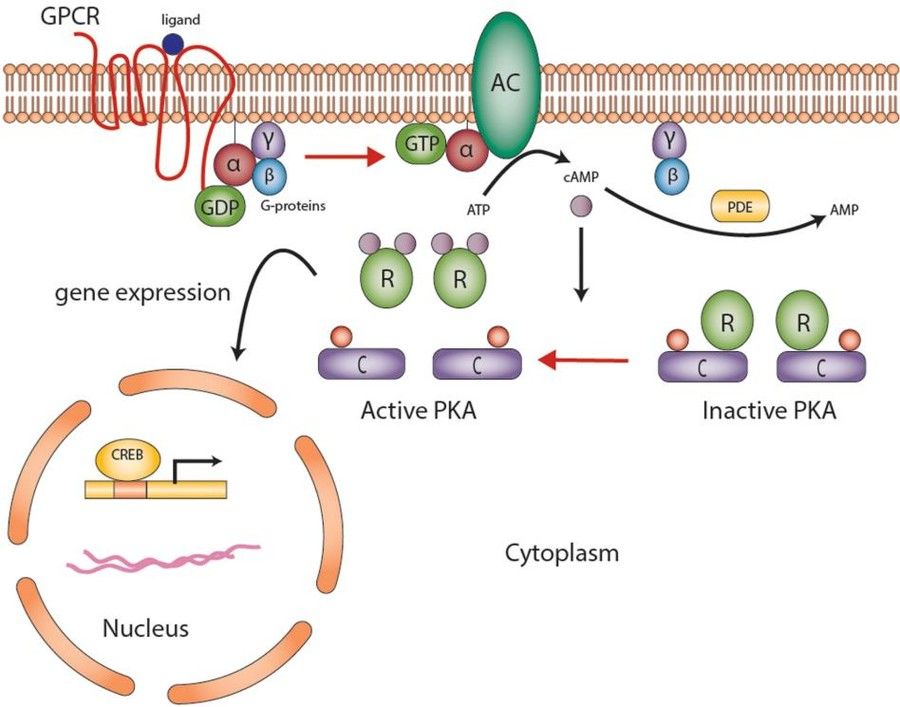Background
Specializing in signal transduction antibodies, Amerigo Scientific provides high-quality G protein-coupled receptors (GPCR) antibodies for advanced GPCR biology research. Featuring high specificity and sensitivity, our products are ideal for applications like Western blotting, IHC, and flow cytometry, empowering your studies of GPCR signaling pathways.
GPCRs are integral membrane proteins crucial for cellular signaling that mediate cellular responses to a diverse array of extracellular signals from photons to ions, neurotransmitters, and hormones. GPCRs consist of an extracellular amino terminus, an intracellular carboxy terminus, and seven transmembrane α-helices connected by intra- and extracellular loops, facilitating ligand binding and signal transduction. Impaired ligand concentrations and dysregulation expression levels of GPCR can lead to many pathophysiological conditions such as cardiovascular diseases, diabetes, and neurological disorders. Targeting of GPCRs is frequently employed for therapeutic intervention, and GPCRs continue to serve as important targets for new drug development.
GPCRs Types
GPCRs are categorized into at least five distinct subfamilies based on their structures and functions. The rhodopsin family accounts for over 90% of all GPCRs.

- Glutamate receptors: Characterized by a large extracellular N-terminus, this class includes metabotropic glutamate receptors, GABA_B receptors, and some taste receptors.
- Rhodopsin receptors: This is the largest class and includes receptors for small molecules, peptides, and hormones. Examples include adrenergic, dopaminergic, and serotonergic receptors.
- Adhesion receptors: These receptors have long N-termini with various protein domains that facilitate cell adhesion and interactions with the extracellular matrix.
- Frizzled/Taste2 receptors: This class includes Frizzled receptors involved in the Wnt signaling pathway and some taste receptors.
- Secretin-like: These receptors primarily bind to large peptide hormones such as glucagon, calcitonin, and parathyroid hormone.
GPCRs Signaling
GPCRs initiate signal transduction upon ligand binding by activating intracellular signaling pathways. Upon ligand binding, GPCRs incur conformational shifts and interact with heterotrimeric G proteins located on the cytoplasmic side of the membrane. This interaction facilitates the exchange of GDP for GTP on the Gα subunit, which separates it from the βγ subunits to further affect distinct signaling pathways. GPCRs participate in two major signal transduction pathways: the cAMP signaling pathway and the phosphatidylinositol signaling pathway. In the cAMP pathway, GPCR activation stimulates adenylyl cyclase to convert ATP into cAMP, activating protein kinase A (PKA). PKA phosphorylates downstream targets, modulating cellular processes like metabolism and gene expression. Conversely, in the phosphatidylinositol pathway, GPCRs activate phospholipase C, cleaving phosphatidylinositol 4,5-bisphosphate (PIP2) to diacylglycerol (DAG) and inositol trisphosphate (IP3). IP3 triggers calcium release from intracellular stores, activating protein kinase C (PKC), which regulates ion channels, cell proliferation, and differentiation.
 Fig.1 The cAMP-dependent signaling pathway.1
Fig.1 The cAMP-dependent signaling pathway.1
GPCRs Functions
GPCRs and G-proteins can be discovered throughout the human body and play a variety of physiological roles, including sensory perception (vision, taste, smell), immune response regulation, neurotransmission, and hormone signaling. Mutations in these proteins can cause a variety of illnesses, from cardiovascular disorders to neurological conditions. Studies have shown that more than 30 human illnesses and syndromes may be linked to the loss or overexpression of GPCRs induced by mutations. These dysfunctions highlight the critical properties of GPCRs in maintaining physiological balance and underscore their prominence as targets for therapeutic interventions.
Amerigo Scientific offers cutting-edge GPCR antibody products, meticulously crafted to target a wide spectrum of GPCR types. Part of the target list is as below. Backed by our expertise and commitment to quality, these antibodies possess unparalleled specificity and sensitivity, ideal for precise research applications.
| ACKR3 |
ADGRG3 |
ADORA1 |
ADORA2A |
ADORA2B |
ADRA1A |
ADRA1D |
ADRA2A |
ADRA2B |
ADRB1 |
| AGTR1 |
AVPR1B |
AVPR1A |
BDKRB1 |
AVPR2 |
BDKRB2 |
CCR4 |
CCR5 |
CHRM2 |
CHRM3 |
| CHRM5 |
CRHR1 |
CXCR4 |
DRD1 |
DRD2 |
DRD3 |
DRD4 |
DRD5 |
EDNRA |
EDNRB |
| GPR143 |
GPR18 |
GPR35 |
GPR55 |
GPR68 |
HCAR1 |
HCAR2 |
HCAR3 |
HRH1 |
HRH2 |
| HRH3 |
HRH4 |
|
Please contact us to discover how our products can elevate your studies in GPCR biology.
Reference
- Hannah-Shmouni, Fady, Fabio R. Faucz, and Constantine A. Stratakis. "Alterations of phosphodiesterases in adrenocortical tumors." Frontiers in Endocrinology 7 (2016): 218956. Distributed under Open Access license CC BY 4.0, without modification.



 Fig.1 The cAMP-dependent signaling pathway.1
Fig.1 The cAMP-dependent signaling pathway.1

